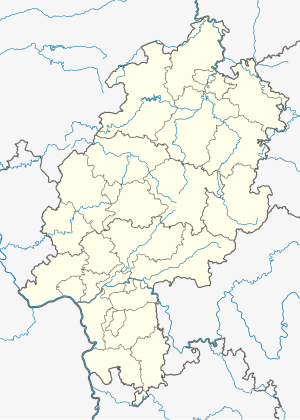Darmstadt waste-to-energy plant
| Darmstadt waste-to-energy plant | |||
|---|---|---|---|
| location | |||
|
|
|||
| Coordinates | 49 ° 53 '2 " N , 8 ° 38' 47" E | ||
| country | Germany | ||
| Data | |||
| Type | Waste incineration plant | ||
| fuel | rubbish | ||
| power |
|
||
| owner | Special purpose association for waste recycling in South Hesse | ||
| operator | Entega | ||
| Start of operations | 1967 | ||
| Chimney height | 100 m | ||
| Energy fed in 2006 | 44 GWh | ||
| Website | www.zas-darmstadt.de | ||
The Darmstadt waste-to-energy plant is a waste-to-energy plant in Darmstadt in southern Hesse . It is one of the most modern in Europe. Up to 214,000 tons of waste are burned here for energy conversion every year. The plant is operated by Entega on behalf of the Zweckverband Abfallverwertung Südhessen (ZAS). Around 75 people are employed in the power plant.
history
The waste incineration plant was put into operation in 1967 with two incineration lines. A third line was completed in 1977. Due to regulatory system throughput restrictions, only two lines were initially allowed to be operated at the same time. With the standards of the 17th Federal Immission Control Ordinance (BImSchV) issued in 1990, a general refurbishment of the waste incineration plant was carried out from 1996 to 1998. With a decision of May 22, 2000, the regional council approved the simultaneous use of all three lines.
To date, over 150 million euros have been invested in the power plant. It is constantly being modernized. The architecture of the complex was accompanied by the Darmstadt architect Theodor Josef Seifert .
In August 2017, the waste-to-energy plant will be completely refurbished for 10.5 million euros and will therefore be completely shut down for the first time in 27 years.
Garbage delivery
The entrance to the MHKW is passed by around 150 garbage trucks every day , which are weighed before they dump the garbage into the unloading gates. The garbage bunker is approx. 3000 cubic meters and holds approx. 1000 tons of waste. Bulky waste is first shredded by the bulky waste shears before it is transported to the garbage bunker by garbage cranes. Such a crane can hold around 2.5 tons per load.
While around 120,000 tons of waste were incinerated annually in the early years, the amount increased to 180,000 tons in 1990 to 210,000 tons (current; as of 2017).
The amount of waste incinerated in the waste incineration plant corresponds to the waste of almost 900,000 inhabitants from 65 cities and towns in the area.
Incineration
The stored rubbish then goes to one of the three incinerators. The combustion temperature is approx. 850 ° C. The waste is constantly rolled around on the grate of the oven and transported onwards so that it dries out faster and ignites more easily. If the waste is completely burned, the slag is placed in a water bath and then brought into a slag shaft by a slag crane. From there, the slag is collected and used, for example, for road construction.
The incineration process reduces the volume of waste by approx. 90% and the mass of waste by approx. 70%. The incineration capacity of the three ovens is 2 × 11 and 1 × 8.3 tons per hour (a total of 30.3 t / h).
power supply
The heat released during waste incineration heats water pipes so that the water in them turns into steam . So it can be used to generate electricity or district heating. This process is called combined heat and power . The energy generated in the power plant is fed into the public power grid after the internal consumption has been reduced. In 2006, 44 million kilowatt hours of electrical energy were provided. The amount is sufficient for the power supply of around 45,000 citizens of the city. The electrical output of the power plant is a maximum of 10 megawatts . Steam output is 78.7 tons per hour. 3600 households are supplied with the resulting waste heat. The thermal output of the power plant is 80 megawatts.
Pollutant emissions
In order to keep the pollutant emissions within limits, the flue gases are cleaned in the flue gas cleaning system and expelled from the 100 meter high chimney at a temperature of approx. 105 ° C.
Individual evidence
- ↑ Record in the thermal power station In: Darmstädter Echo , edition of June 26, 2007
- ↑ a b c Zweckverband Abfallverwertung Südhessen - Müllheizkraftwerk Darmstadt ( memento from March 15, 2008 in the Internet Archive ), accessed on March 2, 2008
- ^ Hessian Court of Auditors, Eleventh Summary Report 2001 ( Memento of March 4, 2016 in the Internet Archive ), item 10.8. Darmstadt waste-to-energy plant
- ↑ a b http://www.born-ermel.de, Darmstadt waste-to-energy plant
- ↑ a b Six weeks of downtime: Darmstadt waste-to-energy plant is being renovated. echo-online.de, August 7, 2017, accessed on August 7, 2017 .
- ↑ [http://www.hse.ag/konzern/download/hse_gb_03.pdf Annual Report of HSE 2003] (link not available)
- ↑ a b [http://www.echo-online.de/3/template_detail.php3?id=508136 PH Gruner, '' Electricity and heat from waste ''] (link not available)
- ↑ a b Zweckverband Abfallverwertung Südhessen - Müllheizkraftwerk Darmstadt, image brochure ( Memento from September 3, 2013 in the Internet Archive ), 1st edition 2011

